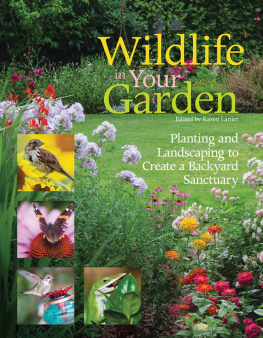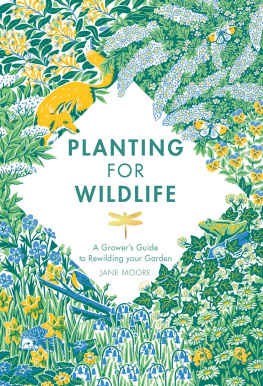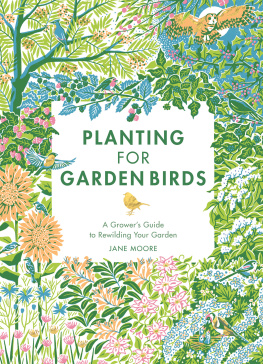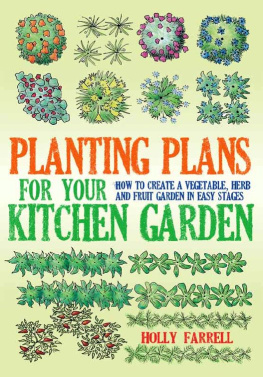Karen Lanier - Wildlife in Your Garden: Planting and Landscaping to Create a Backyard Sanctuary
Here you can read online Karen Lanier - Wildlife in Your Garden: Planting and Landscaping to Create a Backyard Sanctuary full text of the book (entire story) in english for free. Download pdf and epub, get meaning, cover and reviews about this ebook. year: 2016, publisher: I-5 Publishing, genre: Romance novel. Description of the work, (preface) as well as reviews are available. Best literature library LitArk.com created for fans of good reading and offers a wide selection of genres:
Romance novel
Science fiction
Adventure
Detective
Science
History
Home and family
Prose
Art
Politics
Computer
Non-fiction
Religion
Business
Children
Humor
Choose a favorite category and find really read worthwhile books. Enjoy immersion in the world of imagination, feel the emotions of the characters or learn something new for yourself, make an fascinating discovery.
- Book:Wildlife in Your Garden: Planting and Landscaping to Create a Backyard Sanctuary
- Author:
- Publisher:I-5 Publishing
- Genre:
- Year:2016
- Rating:3 / 5
- Favourites:Add to favourites
- Your mark:
- 60
- 1
- 2
- 3
- 4
- 5
Wildlife in Your Garden: Planting and Landscaping to Create a Backyard Sanctuary: summary, description and annotation
We offer to read an annotation, description, summary or preface (depends on what the author of the book "Wildlife in Your Garden: Planting and Landscaping to Create a Backyard Sanctuary" wrote himself). If you haven't found the necessary information about the book — write in the comments, we will try to find it.
Karen Lanier: author's other books
Who wrote Wildlife in Your Garden: Planting and Landscaping to Create a Backyard Sanctuary? Find out the surname, the name of the author of the book and a list of all author's works by series.
Wildlife in Your Garden: Planting and Landscaping to Create a Backyard Sanctuary — read online for free the complete book (whole text) full work
Below is the text of the book, divided by pages. System saving the place of the last page read, allows you to conveniently read the book "Wildlife in Your Garden: Planting and Landscaping to Create a Backyard Sanctuary" online for free, without having to search again every time where you left off. Put a bookmark, and you can go to the page where you finished reading at any time.
Font size:
Interval:
Bookmark:
Your Garden
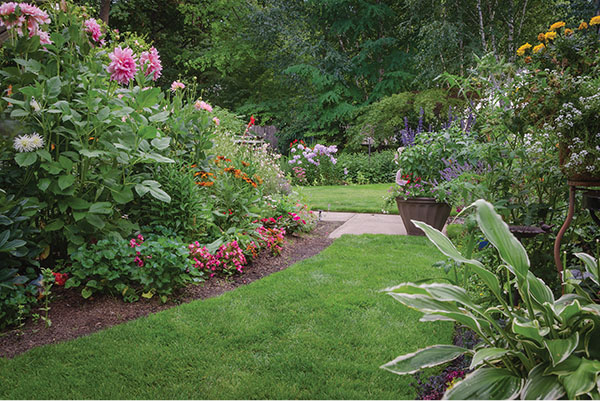
The basic steps in creating a garden that provides a safe habitat for wildlife and functions to improve the environment are:
- Stop using pesticides.
- Replace nonnative lawn turf with native plants.
- Watch and enjoy.
Sound too easy? OKIm oversimplifying matters. You can delve as deep as you want to with Step 2, which can be a process that extends over more than your lifetime. Consider who will be tending the land after you are gone and what kind of legacy you will leave. Have a vision in mind, choose a starting point, and adjust as you go. Use the following concepts to check in with yourself and your garden periodically.

What do the natural areas in your locale look like?
Make Observations
Before you set out to create a backyard wildlife sanctuary, make sure that you understand your local ecology. Find out what the native ecosystem was like before the area was developed. Go to your closest natural areas and spend time simply observing, preferably in all types of weather and all seasons. Take a notebook along and record your observations about the height of the tallest plants, the wildlife you see in each layer, the amount of water and whether it is flowing or still, which plants and animals seem to be thriving, and what might be missing from the landscape.
Talk with naturalists about native wildlife and what they have done to restore the habitats at their sites. Once you start these types of conversations, youll notice that your observation skills will be sharper every time you see landscapes. As Marlene Condon observes in her Nature-Friendly Garden book, The natural world does nothing that is nonsensical. You can take home some of the best ideas and try them out for yourself.
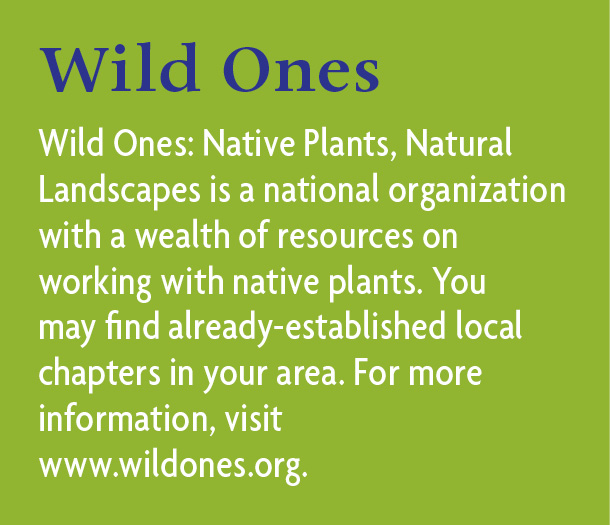
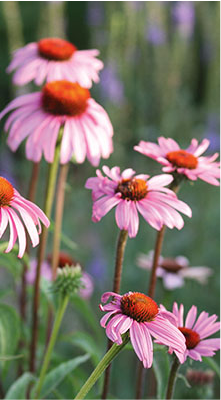
Echinacea, or purple coneflower, is a top pick for Midwestern gardens.
Work with Natives
In nature, nothing exists in a vacuum. Communities, or guilds, of plants grow together because of mutually beneficial relationships, coevolution, and the right growing conditions. In Gaias Garden , Toby Hemenway summarizes what wild nature does best, and we can try to emulate this in our gardens. A healthy plant community recycles its own waste back into nutrients, resists disease, controls pests, harvests and conserves water, attracts insects and other animals to do its bidding, and hums along happily as it performs these and a hundred other tasks. So thats our goal. Native plants offer many advantages toward achieving this state.
In Rick Darke and Douglas Tallamys book The Living Landscape , a native species is defined as a plant or animal that has evolved in a given place over a period of time sufficient to develop complex and essential relationships with the physical environment and other organisms in a given ecological community. Some gardeners like to simplify matters by defining native plants as those that have been in the region since before Europeans arrived on this continent. Native plants generally, but not always, require less maintenance and care than exotic or ornamental species. They dont necessarily stay where you plant them, and they can become even more vigorous than you expected. Natives call for you to be adaptable because you can try to assert your will over them, but they may surprise you. As Darke and Tallamy put it, Managed wildness and an invitational approach to chance happenings can sometimes accomplish things that would be impossible through more deliberate methods.
Intimate relationships between native plants, insects, birds, and other wildlife have evolved cooperatively over millennia. We need to keep an open mind and appreciate that the partnerships that this type of history cultivates are far more complex than the ones that we gardeners might develop with our plants. A few good reasons to select native plants are that they generally have deeper roots and prevent excessive runoff during heavy rains. They help filter and slow down stormwater. They provide essential sustenance to migratory species, such as the monarch butterfly. Also, compared to lawns, they absorb a great deal more carbon from the atmosphere, helping to reduce greenhouse gases.

1. Like a healthy forest, your garden should include multiple layers. 2. Trillium is a spring-blooming plant native to the northeastern United States.
Landscape in Layers
Forest gardening, one aspect of permaculture, promotes establishing several vertical layers of plant communities that form naturally in a healthy forest ecosystem. Your home ecosystem may be prairie or desert, so take that into consideration and adapt the layers to match your areas climate. The following basic outline can be applied to most regions.
The tallest forest garden layer is the canopy. These are the dominant trees, the roof of the garden. The trees crowns are the first to catch and store sunlight, filter air, and recycle oxygen and carbon dioxide. The size and conditions of these big beauties affects all the life underneath; likewise, they reflect the state of affairs going on far below the ground surface.
The layer below the canopy is the understory. This includes younger canopy trees and shorter growing tree species. They compete for light and adapt to maximize the efficiency of their leaves in capturing the suns rays. Some leaf out before the canopy trees in the spring, and some have modified the anatomy of their leaves to function on lower light levels. This is where a graceful transition in design can be made from the towering canopy down to human-scale features.
The middle layer of life is the shrub layer. Shrubs and bushes are usually woody, multistemmed plants up to a height of around 1520 feet. This layer can be a prime shelter for wildlife: a hiding spot midway between the safety of a high nest and the open foraging space on the ground. Berries, nuts, flowers, and foliage all provide something attractive, and a healthy shrub layer will encourage a diverse assortment of wildlife.
The herbaceous layer varies in plant height, with grasses and forbs (flowers and herbs) stretching up to several feet high or creeping low. The diversity of species increases as we move lower down in the forest garden layers, and although the individual plants consist of less mass, they are relatively more productive in their role of supplying food and returning nutrients into the soil. The herbaceous layer is where most of the interesting and colorful blooming plants take turns sharing their colors, fragrances, and textures throughout the seasons.

1. Vines add a decorative touch while benefiting other layers of the garden. 2. Swamp milkweed is popular with monarch butterflies. 3. A monarch caterpillar feeds on a leaf of swamp milkweed.
A layer that can touch all forest garden layers is the vine layer. Vines take up very little space and provide little surprises of color, seeds, and fruit throughout the shrub, understory, and canopy layers. Vines make productive fence decorations and can create screens for privacy. Be cautious when selecting vines because there are some very invasive types (such as certain commonly planted nonnative varieties of honeysuckle and wisteria) that will take over. Opt for the native varieties so that wildlife will find what they need.
Next pageFont size:
Interval:
Bookmark:
Similar books «Wildlife in Your Garden: Planting and Landscaping to Create a Backyard Sanctuary»
Look at similar books to Wildlife in Your Garden: Planting and Landscaping to Create a Backyard Sanctuary. We have selected literature similar in name and meaning in the hope of providing readers with more options to find new, interesting, not yet read works.
Discussion, reviews of the book Wildlife in Your Garden: Planting and Landscaping to Create a Backyard Sanctuary and just readers' own opinions. Leave your comments, write what you think about the work, its meaning or the main characters. Specify what exactly you liked and what you didn't like, and why you think so.

